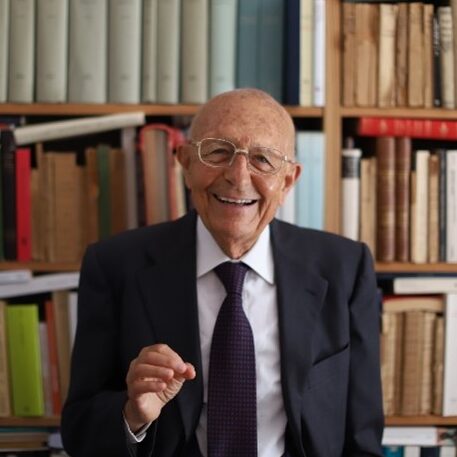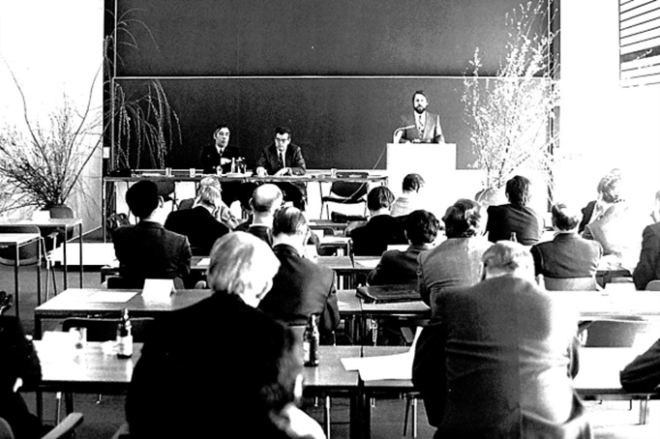Disciplinary Entanglements, Collective Reflections
One of the major developments of public law scholarship in the last half century has been the enlargement of the study of public law, from studying the law to studying also the various approaches to the law and their changes over time.
This is a process of self-consciousness comparable to the revolution produced by the publication, in the second half of the Sixteenth century, of the “Essais” by Michel de Montaigne, because now lawyers study not only law, but also legal scholarship (that is how lawyers study law). This development has introduced a new canon in the legal culture.
For this reason, a collective reflection on the history of the Max Planck Institute for Comparative Public Law and International Law is particularly important and useful, if we succeed in situating this reflection in the larger framework of the history of legal thought in the area of public law.
Disciplinary entanglements among public international law, European public law, and comparative public law (but also between public law and private law) progress in time as the product of a double development, one at the level of the legal change, the other in the scholarly dimension. The first is the erosion of state power, the second the crisis of the positivistic approach to science and to legal scholarship. Both phenomena have prompted a set of transformative developments in the field of public law.
Five new Developments
A first development is the blurring of the frontiers between the national dimension of the law and the foreign and supranational dimension. As in the XVI and XVII centuries national European courts, the “lex alius loci” (the law of another country) becomes relevant[1].
Article 6(3) TEU provides that: “[f]undamental rights, as guaranteed by the European Convention for the Protection of Human Rights and Fundamental Freedoms and as they result from the constitutional traditions common to the Member States, shall constitute general principles of the Union’s law.”[2] A similar clause is found in the Treaty on the Functioning of the European Union (TFEU), Article 340. The reference to the legal orders of the Member States of the European Union as sources of Union law is reiterated in the Charter of Fundamental Rights of the European Union, albeit with different wording (first “principles” and later “traditions”: Article 41(3) and Article 52(4)).
These provisions introduce an entirely new manner of lawmaking. The first is that the higher law is made up of the lower law, through a process of absorption. Therefore, in the area of fundamental rights, the “general principles” of European law are the result of a complex “two-way” process, because they first proceed from the bottom up, and then from the top down. The higher law can derive from lower law; the “general principles” do not drop down from the top. This process launches a “dialogue” between the two levels of government, and is proof of their reciprocal openness. “The inclusion of Member States’ law in the concept of European law” produces a “European conglomerate of legal norms of different legal orders”[3].
The second peculiarity is that this vertical two-way procedure also requires a horizontal, comparative process, because the commonalities must be discovered through a comparison of traditions. Comparison becomes a part of the norm-setting procedure. However, at the same time, this use of comparison has an impact on the identity of this branch of legal scholarship, which thus becomes an instrument to develop concepts and institutions that transcend individual national legal orders. Comparative law replaces legal comparison and to some extent can be considered as binding law[4].
A second development is the blurring of the borders between public and private law. To overcome the different national approaches to the public/private law divide, European law has introduced the notion of “body governed by public law” “established for the specific purpose of meeting needs in the general interest, not having any industrial or commercial character”[5]. This new notion crosses the public/private law divide, is based on substantial and not formal elements, goes beyond the national dividing lines of private and public law.
A third development is the rediscovery of the role of legal scholarship as a major element of the legal order: culture and epistemic communities become a part of the study of law as they have an impact on the legal order through system building and interpretation. Therefore, it is vital to study the historical developments of legal scholarship as a part of the legal systems at the national and at the supranational level, taking into account the divergent legal approaches and crossing borders between States, disciplines and the public and private divide.
A fourth development is the overcoming of the traditional border between the legal space and the non legal (political, social) dimension. Thanks to this development, it becomes possible to study and understand the reciprocal influences of scientific management and Taylorism, on one side, and the regulation of administrative procedure by judges and legislators, on another side. This convergence of learning overcomes fragmentation of science and encourages integration of points of view and cultures that were separated: the life of law is not only norms and judgments, not only legal orders and systems, not only legal concepts, but also history, culture, “mentalité”, and our task is to reassemble what has been divided in the last two centuries.
A fifth development is the recognition that foreign, transnational, supranational, and global law are not only an object of scientific analysis by national scholars belonging to a different legal system, but also “goods” or “merchandises” imported from the outside into a different legal order, that have effect due to their normative or quasi–normative role both in the original system and in the importing country. This is because legal systems are open or porous (treaties and agreements abolish barriers to money transfers and to trade; and money and trade are instrumental to the transplant of legal institutions); there are some characteristics, institutions, procedures, rules, practices, common to more than one national legal system; legislators get “inspiration” from comparison, and, therefore, they have to adjust national legal systems to the prevailing institutions in the most developed nations; national courts, for their part, establish links with foreign legal orders via comparison; legal scholarship is not bound to a nationalistic approach, and comparative law experts may not only study, but also suggest or advise, on the basis of comparison; comparison is not a pure intellectual effort to know each other; it assumes a practical function; as a consequence, legal scholarship can proceed from legal comparison (“Rechtsvergleichung”) to true comparative law; comparative lawyers establish a transnational legal discourse and act as “merchants of law”; finally, comparison becomes a “source of law”, with donor countries and receptor countries (that in some cases improve the model and become donors for other countries)[6].
Looking to the Future
Due to these developments, public law has changed and is changing. Three important aspects of this change are: the overcoming of the national limitation of law, the transdisciplinary opening of the splendid isolation of the legal method, and the modifications of the grammar of law (and its traditional conceptual grounding in Roman law).
Today’s imperative is to abandon exclusive legal nationalism. This does not mean not cultivating national law, but recognizing its necessary interdependence with other national laws, regional legal orders, and universal principles.
The second imperative is to build bridges between law, the “humanities” and the “social sciences”, because law is a social science. This does not mean to abandon the “legal method”, but to integrate it with other disciplines.
The third imperative is the construction of a more comprehensive language and grammar. The vehicular language is now English, spoken by a billion and a half inhabitants of the earth. The grammar is that developed by the various branches of the science of law almost everywhere in the world.
In its centennial history, the Max Planck Institute for Comparative Public Law and International Law has become an innovative and attractive forum and center of the world’s epistemic community in public law. The combination of open-mindedness, richness of seminars and discussion, efficiency, and continuity attracts the best scholars in the field, junior and senior, a combination that has produced some of the best comparative pieces in the field of public and international law.
One can only hope that the Institute will continue along its well established traditions. One can expect and hope that in the future it will also combine researches on the State with the study of non-State actors and indirect rule, and match the study of legal doctrine and theory with a problem-oriented approach, open to non-legal methodologies.
As side by side to the State-pyramid have developed the State-network, and recently the State-archipelago, while the borders between internal and external public law become blurred, and the State is flanked by non-State supranational and global actors, attention must be given also to these new bodies.
Legal institutions and processes do not live in a vacuum, their study cannot proceed without taking into account political, sociological, cultural aspects. Therefore, while being using the tools of the trade, possessing full mastery of the legal techniques, perfect command of the principles, lawyers assembling at the Institute should also strive for a more open study of law.
My final conclusion is an invitation: cross borders, be a trespasser, go “beyond the State, beyond the West, beyond the law”[7]!
A comprehensive version of this article will be published in the Zeitschrift für ausländisches öffentliches Recht und Völkerrecht.
[1] Gino Gorla, I tribunali supremi degli Stati italiani, fra i secoli XVI e XIX, quali fattori di unificazione del diritto nello Stato e della sua uniformazione fra Stati, in: Bruno Paradisi (ed.), La formazione storica del diritto moderno in Europa, Firenze: Olschki 1977, 447 ff.
[2] On the origins of the general principles of EC law, see Paul Craig, UK, EU and Global Administrative Law. Challenges and Foundations, Cambridge: Cambridge University Press 2015, 323.
[3] Armin von Bogdandy, The Current Situation of European Jurisprudence in the light of Schmitt’s Homonymous Text, unpublished paper, 15.
[4] I have developed these points in: Sabino Cassese, Ruling from below: common constitutional traditions and their role, N.Y.U. Environmental Law Journal 39 (2021), 591-618. On the methodologies of comparison, see Ran Hirschl, Comparative Methodologies, in: Roger Masterman/Robert Schütze (eds), The Cambridge Companion to Comparative Constitutional Law, Cambridge: Cambridge University Press 2019, 11 ff.
[5] Art. 1 directive 18 of 2004; see also CJEU, Gemeente Arnhem and Gemeente Rheden v BFI Holding BV, Judgement of 10 November 1998, case no. C-360/96, ECLI:EU:C:1998:525.
[6] I have made these points in: Sabino Cassese, Beyond Legal Comparison, in: Annuario di diritto comparato e di studi legislative, Napoli: Edizioni Scientifiche Italiane 2012, 387-395.
[7] This is a synthesis made by Tommaso Amico di Meane, Sulle spalle dei giganti? La questione metodologica del diritto comparato e il suo racconto, Napoli: Editoriale scientifica 2022, 336.
|
Suggested Citation: Sabino Cassese, Being a Trespasser, MPIL100.de, DOI: 10.17176/20240219-171434-0 |
|
| Lizenz: CC BY-NC-SA 4.0 DEED | |

Sabino Cassese was a Professor of Administrative Law and a judge of the Constitutional Court of Italy. He was a Professor at the Universities of Urbino, Naples and Rome. Professor Cassese was a member of the Italian government as well as the President of the European Group of Public Administration.


